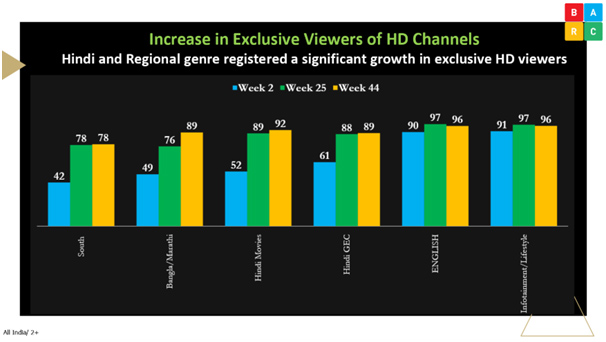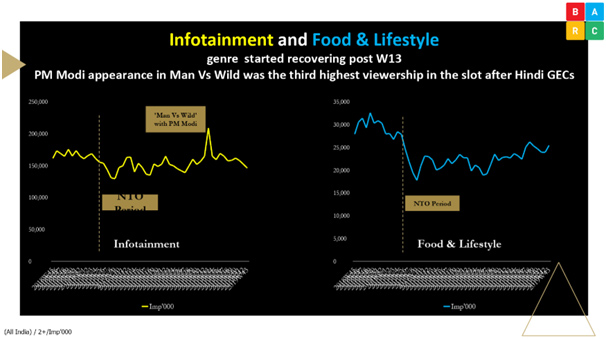MUMBAI: It’s taken a while but slowly and steadily the benefits of TRAI’s new tariff order (NTO) is starting to show. Broadcast Audience Research Council (BARC) India data shows that high definition (HD) channels have seen a positive impact and the average time spent (ATS) in the post NTO era.
In his presentation at the Video and Broadband Summit 2019 organised by Indiantelvision.com on 11 December, BARC chief operating officer Romil Ramgharhia informed:
- Exclusive viewers for South Indian HD channels grew from 42 per cent in week 2 to 78 per cent in weeks 25 to 44
- Exclusive viewers for Bengali and Marathi HD channels saw an increase from 49 per cent in week 2 to 76 per cent in week 25 to 89 per cent in week 44
- Exclusive viewers for Hindi movies HD channels saw an increase from 52 per cent in week 2 to 89 per cent in week 25 to 92 per cent in week 44
- Exclusive viewers for Hindi GEC HD channels saw an increase from 61 per cent in week 2 to 88 per cent in week 25 to 89 per cent in week 44.

Average time spent (ATS) during the NTO dipped down to 3 hours and 39 minutes but post NTO it has risen to 3 hours and 44 minutes.
An Indian consumer in the pre NTO era, on average, consumed around 3 hours and 40 minutes of TV, in which he used to watch 10 to 15 channels per day and 25 to 30 channels per week. However, in the post NTO era, an Indian consumer watches around 12 unique channels in a day and around 30 unique channels per week.
Total TV viewership over the past four years has grown by 45 per cent from 2016 to 2019.
Hindi GEC and Hindi movies are the two largest shareholders in terms of viewership consumption. The two had a 76.5 per cent share in 2018 but in 2019 the share has fallen to 75 per cent. “The reason for the dip is because, in the pre-NTO era, the consumer viewed around four flagship channels on Hindi GEC and the share was 23 per cent, but in the post-NTO era, the consumers made a choice of watching two out of four channels which brought the share down to 13 per cent. Similarly, for Hindi movie channels, consumers have chosen around three out of five channels from pre to post-NTO era and the share has dipped from 35 per cent to 23 per cent,” Ramgharia said.
Both news and sports have increased their share due to big events that took place in 2019. News genre's growth was driven by Pulwama & Balakot attacks, General Elections and Article 370 while sports' growth was driven by ICC World Cup 2019.
Ramgharia also informed that among regional channels, Marathi and Tamil were popular.


Post NTO, infotainment is the only niche genre that saw viewership growth. The viewership increased on Discovery when Indian prime minister Narendra Modi appeared on Man vs. Wild. The channel was operating at 6.9 million impressions with 18.4 million unique viewers and 400 million viewing minutes. Even food & lifestyle during the NTO era had a negative impact, but in the post NTO era, its viewership raised up and stabilised.

English entertainment channels (EEC) and English movies channels (EMC) saw a negative impact during the NTO era, but in the post NTO era the viewership on EEC and EMC have increased and stabilised. Viewership on kids’ channels increased when the vacation started in the post NTO era and now is in a stabilised position. Channels for music and youth also saw an immediate increase in viewership, unlike others genres in the post NTO era because these channels are free to air and over a period of time the viewership on music and youth channels is stabilising, Ramgarhia added.
Viewership has grown for IPL by 53 per cent from 2016 to 2019. In 2016, on Sony, it had 1.03 billion impressions, which grew up to 1.25 billion impressions in 2017 on the same channel. In 2018, when NTO was not implemented, IPL had 1.43 billion impressions on Star Sports channel which grew up to 1.58 billion impressions, on the same channel, even during and post NTO era in 2019. Kaun Banega Crorepati’s (KBC) average impressions per episode in 2018 were 5.75 million, which grew up to 6.26 million impressions per episode on an average basis.
Ramgarhia also mentioned that there are around 100 mn households without TVs at their homes. So, there is a long way to go for TV and it will work out in a positive manner.






